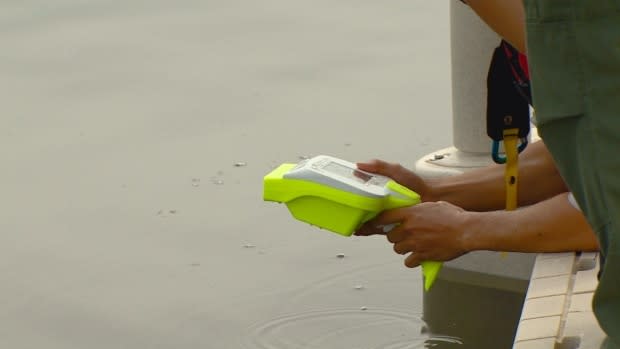Search and rescue test sonar technology to locate human bodies under water
Following a drowning, it can take hours, sometimes days to locate a body.
But rescue services hope a new sonar device can reduce the time to find a human body significantly, helping families seek closure much faster.
AquaEye is a handheld underwater scanner that uses sonar and artificial intelligence to detect human bodies underwater. Search and Rescue groups and the RCMP tested the device on Saturday morning at Pigeon Lake, located about 65 kilometres southwest of Edmonton, but were disappointed to learn it did not work as well in Prairie waters as it did in the lakes of British Columbia.
"Here we have algae and seaweed so there is going to be a lot more testing," said Wayne Benson, fire chief at South Pigeon Lake.
"It's a very good idea but unfortunately it wasn't compatible with the conditions we presented to it," he said.
However, they have not given up hope. The product is a work in progress and the company and rescue services will continue testing to make sure AquaEye works in murkier conditions as well.
Alberta has seen more than a dozen drownings this year, including a recent one at Pigeon Lake. The bodies of a man and woman were found on the shoreline of the lake on Saturday, Aug. 8. On Tuesday, three family members lost their lives after being swept under Crescent Falls in western Alberta.
Benson said oftentimes when they get reports of drownings, it can take them multiple hours to locate a body using what they refer to as the grid system.
"At the beginning our SAR [search and rescue] Sea-Doo did grids on the surface, looking for the opportunity to see anything in the water, and then normally the divers would go in," he said.
He said the process can take hours to days depending on the size of the water body. But the AquaEye cuts that time considerably as it can scan about five acres in a couple of minutes.

"It'll scan those, it'll come up with anomalies and it'll differentiate between what it feels is a body versus another anomaly and then we can just go deal with that anomaly rather than taking all the extra time that's put into grids," Benson said.
Declan Johnston, product engineer at VodaSafe, the company that designed the device, was on site to help search and rescue services test the product.
"It uses sonar so it's bouncing sound waves off of objects and reading the reflections and then it uses AI [artificial intelligence] to process those signals and determine what is a human," he explained.
Johnston said the product was originally dreamt up by an engineer and lifeguard who recognized a gap in life-saving tools.
"It was originally a tool for lifeguards but it has quickly grown into a tool used by fire departments and police as well," he said.
He said AquaEye is currently deployed at some camps and city lifeguarding stations in Canada and the United States.
"And it is becoming more adopted with fire departments and police," he said.
However, Benson said Johnston will be returning to the lake to gather more data to increase AquaEye's ability to scan in much murkier conditions.

